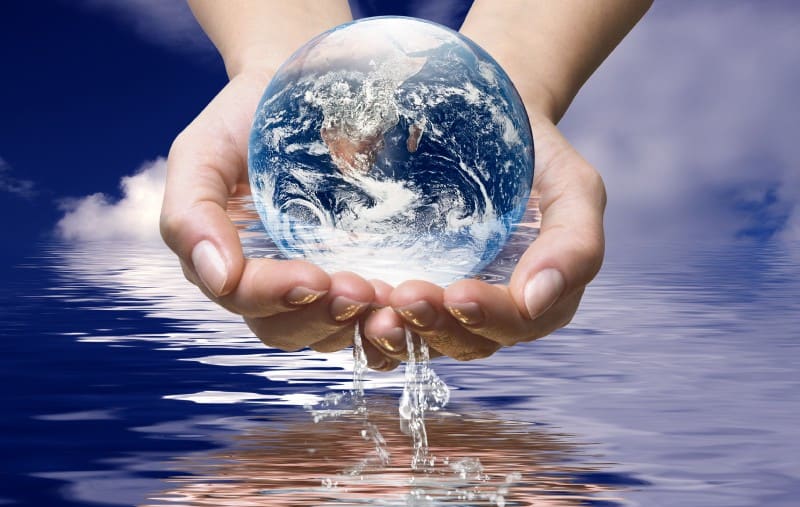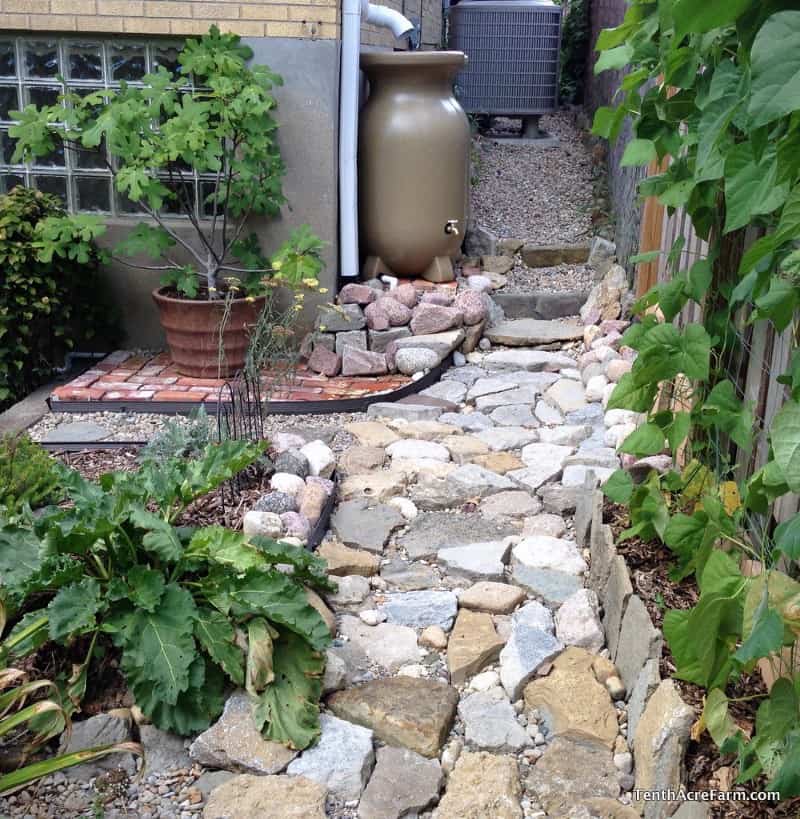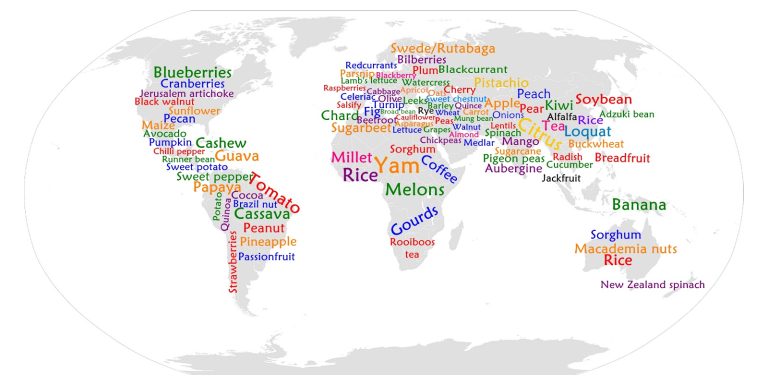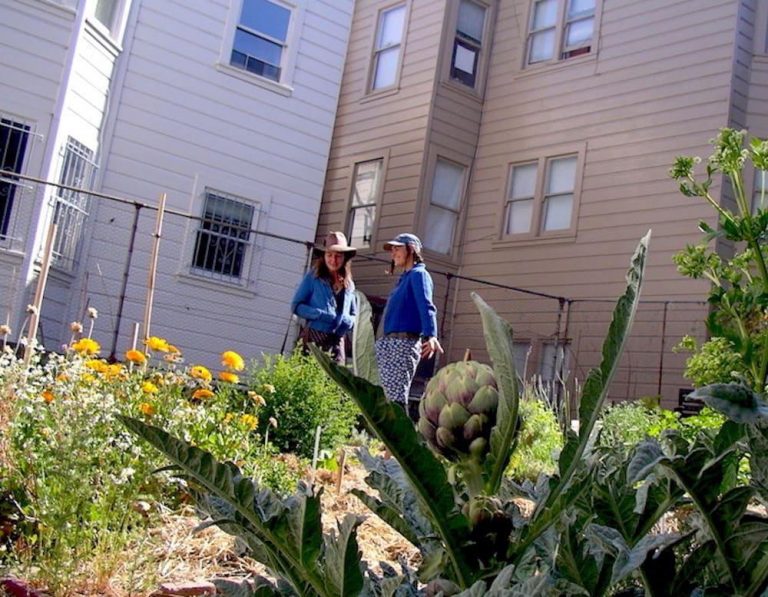See where water is being lost or wasted with permaculture water design.
By Amy Stross
Water is the most essential element to life on earth. Take a moment and really let that sink in. Do your everyday practices demonstrate a reverence for this finite resource? The permaculture design process can help you protect and care for the water in your life and community. It can also ease the irrigation burden in your food-producing systems.
When you’ve managed water well, whether in your home, garden, or community, other elements in the system will come alive. Now that’s powerful.

Water: The Most Revered Element on Earth?
For many of us, clean water comes directly from a tap in an instant. Because of this, it’s easy to forget how finite this resource is, and how our practices regarding water may be unsustainable.
Upon further inspection, one realizes there is not a single organism on earth that can live without it. Good thing we’re living on the Blue Planet, right?
Well, the truth may shock you. It turns out that only .5% (!) of all water on earth is freshwater, available to us. Much of the rest is locked in ice or deep in the earth’s crust. In other words, our most precious and important resource is amazingly finite.
For this reason, most native peoples have traditionally honored this element’s sacredness. When your life is closely entwined with — and dependent on — access to clean water, you protect it, rejoice, and give thanks for its presence.
Modern civilization on the other hand, has become disconnected to water’s sacredness due in large part to the convenience of modern systems.
Less than 200 years ago, modern indoor plumbing hit the scene. This highly engineered system brings water efficiently to each household. However, it also sends away water that was used only once faster than it came.
When people become intrigued by permaculture design, they usually expect to learn how to apply permaculture principles to a landscape. In truth, when we cultivate a relationship with water, our actions can benefit much more than a single landscape. While our gardens may be more resilient and robust with permaculture design, so, too, can our local watershed and ecology.
Permaculture design allows us to think about our place within the system as a whole. In this article we’ll check out ways to become better stewards of water in all areas of life.
Looking in the Mirror: Personal Water Use
Part of the permaculture design process is looking to see where resources are being lost or wasted.
The average American uses 1200 gallons of water per day. In the U.S. alone, vast underground aquifers that have taken more than 2 million years to develop, are depleting faster than they can be replenished. This is largely because of consumer habits and a lack of reverence for water.
Are you wondering what you can do to better care for this wasted resource in your personal life? From eating organic food to eschewing packaged foods, these 10 tips can help.
In the western world especially, we must find ways to respect and conserve this vital resource, as if our lives depended on it, because they do!
Closing the Loop in the Home Water Cycle
The typical pathway for water in a municipal system is this: Clean water is pumped into the home. It’s used only once before it is whisked away again to the municipal treatment plant for cleaning. This is a very energy intensive cycle to filtrate, pump, and collect waste water that so quickly enters and leaves the home.
An ecological home water cycle, on the other hand, seeks to retain and recycle water onsite whenever possible. For example, greywater — the used water from sinks, showers, and washing machines — can potentially be used in the landscape.
While this might seem unsanitary, in fact, soil organisms are pretty efficient at filtering and sanitizing. Utilizing greywater onsite is quite possibly the next frontier — after recycling and composting — for reducing household waste.
Seeking out ways to utilize greywater helps us to be more mindful of both water use and water cleanliness. When I know water is headed for my garden rather than to the municipal treatment plant, I’m more mindful of what I add to the water.
If you would like to explore ways to take advantage of greywater to connect the inside of your home with your landscape, or other sustainable water topics, check out the wealth of information and ideas at GreywaterAction.org.
Take advantage of these water opportunities so you can conserve water, reduce pollution and the strain on sewer systems, add fertility to the garden, and create a dynamic, living water cycle within the home that is integrated with the landscape.
Let’s look outside and see how you can design a landscape that respects and cares for water.
What’s Your Local Watershed Got To Do With It?
It is essential to know where a landscape is situated within its local watershed in order to apply permaculture design to the site. A single landscape is just one part of a larger system, and our goal is to support regenerative ecosystems as a whole.
Understanding how water moves throughout a watershed helps you to visualize where water is being wasted in the landscape. Armed with this knowledge, you can find appropriate ways to manage it.
Try this exercise: Look at the water that comes in and out of a landscape. Where does it come from? Is the source clean or polluted? When it leaves a site, where does it go?
When you think about your landscape as part of a whole watershed, you can look for ways to conserve water and maintain water purity.

Conserving Water in the Productive Landscape
Observe where water is being lost or wasted in a garden. Armed with this knowledge, you can look for smart ways to make the system more robust and interconnected. Sometimes the solution is as straightforward as building soil, mulching appropriately, or routing a downspout so that it discharges in the garden as passive irrigation.
Other times, the solution is more involved. For example, earthworks are man-made structures that change the topography of the land in order to direct and manage water. On some sites, the goal will be to redirect excess water, while on other sites earthworks encourage infiltration.
The permaculture design process can help you assess a landscape for its particular qualities and find ways to manage water appropriately.
The water that falls or collects on a site is a precious resource. In a permaculture design, the aim is to use water as many times as possible before it passes out of the system and to send only clean water into your local watershed.
Seek Out Native and Local Water Wisdom
Dr. Chika Ezeanya-Esiobu was working as a consultant for the World Bank in Washington, D.C. One day, she overheard her boss complaining about an irrigation project that had cost millions of dollars to build. The solution in the Republic of Niger was falling far short of its intended goals to bring irrigation to crops. Of course, irrigation is essential for agriculture in this region that is 75% parched desert.
Meanwhile, a traditional irrigation method in the region, called tassa, demonstrated glowing results. Plots of land growing millet using the tassa method were 98% more productive than plots of land not using the method. That’s an incredible increase in productivity using a hand-dug technique! Watch Dr. Ezeanya-Esiobu’s TED Talk here.
These results are encouraging, but not surprising. After all, native techniques tend to be low-tech, low-cost, and work with the land to produce a lasting and water-wise solution.
You might find yourself aghast at the wastefulness and over-engineering of the World Bank solution and its disconnect with the local ecology and people. It’s easy to judge that which is removed from our own experience. As such, when we circle back to our own bioregion of the world, we must be vigilant about solutions that are disconnected from the qualities and needs of a landscape or community.
Remember the over-engineered municipal water system that sends filtered water all the way to your home to be used only once before being disposed of as waste? Learn to discover where resources are being lost and seek out specific strategies that match the needs of a site. Why invent the wheel when there may be an appropriate, low-tech solution right under your nose?
Design with water in mind, and you’ll observe a powerful, integrated system (whether in your home, garden, or community) come to life.
Would you like to learn more?
Read more of my writing about creating regenerative food-producing systems on my website, TenthAcreFarm.com.



